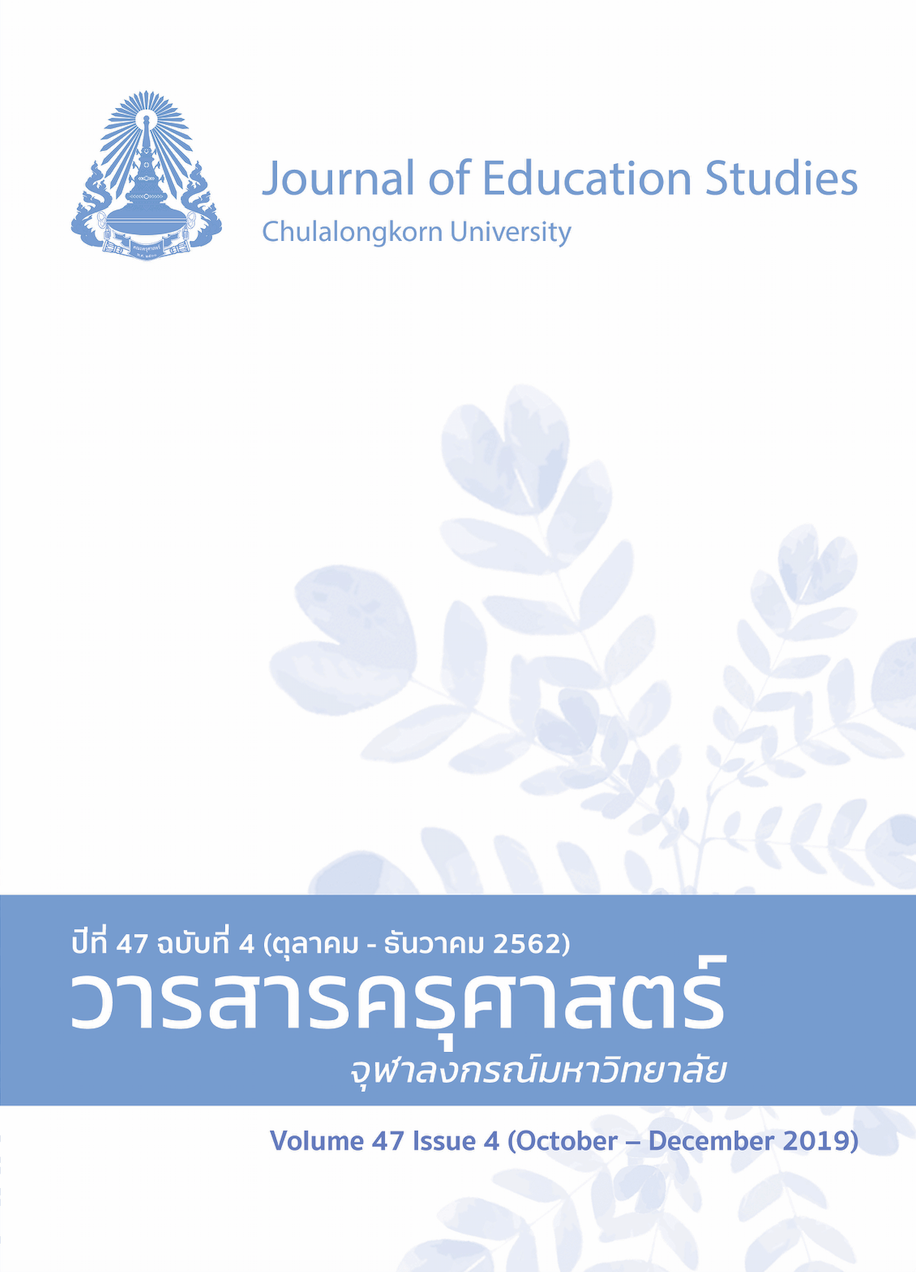Causal Factors of Educational Supervision Influencing Competencies of Teachers in the Opportunity Expansion Schools under the Pracharath School Project
Keywords:
PRACHARATH SCHOOL, TEACHER COMPETENCY, EDUCATIONAL SUPERVISIONAbstract
The objectives of this study were to 1) investigate the causal models of factors in educational supervision influencing teachers’ competencies; 2) examine the correlation between the models and the empirical evidence and 3) analyze the variation of causal relationships of educational supervision influencing teachers’ competencies. The population included 21,812 teachers in the opportunity expansion schools under the Pracharath School Projects, 1,040 of whom were selected as participants based on multi-stage random sampling. The research tool was a questionnaire. In addition to SPSS for Window Version 21 and R, inferential statistics, reference statistics, confirmatory factor analysis and structural equation modeling were applied to analyze the data.
The findings revealed that (1) supervisory patterns, supervisory behaviors and supervisory activities were causal factors that influenced the teachers’ competencies; and (2) the correlation between the 4-models and the empirical evidence were strongly correlated (3) therefore, four causal models could be constructed as follows: 1. Clinical supervision model, in which supervisory patterns were the variables that directly influenced the teachers’ competencies most ( = 0.44) with statistical significance at .05 2. Cooperative professional development supervision model, in which supervisory behaviors were the variables that directly influenced the teachers’ competencies most ( = 0.42) 3. Self-development supervision model, in which supervisory patterns were the variables that directly influenced the teachers’ competencies most ( = 0.79) with statistical significance at .05 4. Administrative supervision model, in which supervisory patterns conducted by administrators were the variables that directly influenced the teachers’ competencies most ( = 0.36)
References
คณะทำงานโครงการสานพลังประชารัฐ. (2560). การติดตามการพัฒนาการศึกษาพื้นฐานและการพัฒนาผู้นำ. ในการประชุมวิชาการเพื่อนำเสนอผลการดำเนินโครงการผู้นำเพื่อการพัฒนาการศึกษาที่ยั่งยืน (CONNEXT ED). ครั้งที่ 7 วันจันทร์ที่ 6 พฤศจิกายน 2560. กรุงเทพมหานคร: สำนักงานโครงการผู้นำเพื่อการพัฒนาการศึกษาที่ยั่งยืนในโครงการสานพลังประชารัฐด้านการศึกษา (E5).
จุไรรัตน์ สุดรุ่ง. (2559). การนิเทศภายในโรงเรียน. กรุงเทพมหานคร: แดเน็กซ์อินเตอร์คอร์ปอเรชั่น.
นงลักษณ์ วิรัชชัย. (2542). โมเดลลิสเรล: สถิติวิเคราะห์สำหรับการวิจัย. กรุงเทพมหานคร: โรงพิมพ์แห่งจุฬาลงกรณ์มหาวิทยาลัย.
พรรณทรี โชคไพศาล. (2543). พฤติกรรมการนิเทศที่ส่งผลต่อการเปลี่ยนแปลงพฤติกรรมการสอนของครู (วิทยานิพนธ์ปริญญามหาบัณฑิต ไม่ได้ตีพิมพ์). จุฬาลงกรณ์มหาวิทยาลัย, กรุงเทพมหานคร.
วัชรา เล่าเรียนดี. (2556). ศาสตร์การนิเทศการสอนและการโค้ช การพัฒนาวิชาชีพ: ทฤษฎี กลยุทธ์สู่การปฏิบัติ (พิมพ์ครั้งที่ 12). นครปฐม: โรงพิมพ์มหาวิทยาลัยศิลปากร วิทยาเขตพระราชวังสนามจันทร์.
สถาบันพัฒนาครู คณาจารย์ และบุคลากรทางการศึกษา. (2559). การประเมินสมรรถนะครูและบุคลากรทางการศึกษาเพื่อจัดทำแผนพัฒนาตนเอง (ID-PLAN) และแผนพัฒนาความก้าวหน้าในวิชาชีพ (Career plan). นครปฐม: ฝ่ายวิชาการ โครงการพัฒนาระบบการพัฒนาครูและบุคคลากรทางการศึกษา.
สถานบันทดสอบทางการศึกษาแห่งชาติ (องค์การมหาชน). (2555). รายงานผลการจัดสอบทางการศึกษาระดับชาติขั้นพื้นฐาน (O-NET). กรุงเทพมหานคร: สถานบันทดสอบทางการศึกษาแห่งชาติ (องค์การมหาชน).
สำนักงานเลขาธิการคุรุสภา. (2556). สาระความรู้ สมรรถนะและประสบการณ์วิชาชีพของผู้ประกอบวิชาชีพครู ผู้บริหารสถานศึกษา ผู้บริหารการศึกษา และศึกษานิเทศก์ ตามข้อบังคับคุรุสภา ว่าด้วยมาตรฐานวิชาชีพ พ.ศ. 2556. กรุงเทพมหานคร: คุรุสภาลาดพร้าว.
สำนักงานคณะกรรมการการศึกษาขั้นพื้นฐาน. (2559). สถิติทางการโรงเรียนประชารัฐ. สืบค้นจาก: http://203.159.154.241/innogoth/
ภาษาอังกฤษ
Anderson, J. C., & Gerbing, D. W. (1988). Structural equation modeling in practice: A review and recommended two-step approach. Psychological Bulletin, 103(3), 411-423.
Barbara, M. B. (2012). Structural equation modeling with Mplus: Basic concepts, application, and programming. New York: Taylor & Francis Group.
Beach, D. M., & Reinhartz, J. (2000). Supervision leadership: Focus on instruction. Boston: Allyn and Bacon.
Boyan, N. J., & Copeland, W. D. (1978). Instructional supervision training program. Columbus, OH: Charles E. Merrill.
Glatthorn, A. A. (1984). Differentiate supervision. Washington D.C.: Association for Supervision and Curriculum Development.
Glickman, C. D., Gordon S. P., & Ross-Gordon, J. M. (2010). Supervision and instructional leadership: A developmental approach (8th ed.). Boston: Allyn and Bacon.
Glickman, C. D., Gordon, S. P., & Ross-Gordon, J. M. (2018). Supervision and instructional leadership: A developmental approach (10th ed.). Upper Saddle River, NJ: Pearson Inc.
Hvidston, D. J., McKim, C. J., & Mette, I. M. (2016). Principals’ supervision and evaluation cycles: Perspective from principals. Education Leadership Review, 17(1), 100-113.
Perera-Diltz, D. M., & Mason, K. L. (2012). A national survey of school counselor supervision practices: Administrative, clinical, peer, and technology mediated supervision. Journal of School Counseling. Montana State University International of Education Sciences, 10(4), 1-34.
Sergiovanni, T. J., & Starratt, R. J. (2007). Supervision: A redefinition. New York: McGraw-Hill.
Sergiovanni, T. J., & Starratt, R. J. (1988). Supervision: Human perspective (4th ed.). Thousand Oaks, CA: Corwin.




